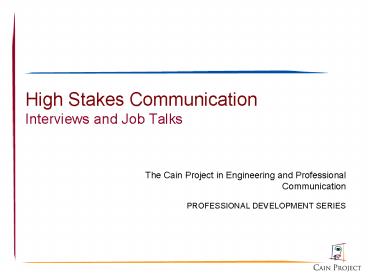High Stakes Communication Interviews and Job Talks - PowerPoint PPT Presentation
1 / 30
Title:
High Stakes Communication Interviews and Job Talks
Description:
The Cain Project in Engineering and Professional Communication. PROFESSIONAL DEVELOPMENT SERIES ... http://www.uni-koblenz.de/~vladimir/breviary/dilbert-powerpoint.gif ... – PowerPoint PPT presentation
Number of Views:147
Avg rating:3.0/5.0
Title: High Stakes Communication Interviews and Job Talks
1
High Stakes CommunicationInterviews and Job Talks
The Cain Project in Engineering and Professional
Communication PROFESSIONAL DEVELOPMENT SERIES
2
Successful Candidates
- Analyze situation and audience
- Organize knowledge and experience
- Convey confidence and professionalism
- Give great job talks
- Handle questions
3
Research Your Employer
- Mission
- Organizational structure and culture
- Products, services, clients
- Research foci, facilities
- Financial standing
- Size and location
4
Sources of Information
- Web sites
- Annual report
- Promotional materials
- Advisors, peers
- Conferences and meetings
- Journals
5
Know Yourself
- Assess strengths and weaknesses
- List life and career goals
- Create table of key job satisfaction factors
- Stay aware of current events
6
Know Your Work History
- Evidence from earlier résumés
- Technical skills
- Supervising or mentoring
- Service
7
Get Organized
- Review notes on employers
- Match your qualifications to their needs
- Formulate questions to ask
8
Show What You Know!
- Greeting
- Start with a confident, Can-Do statement
- Road Map
- Deliver topic sentences
- Provide concrete examples
- Organize for clarity
- Adapt to audiences interests
- Closing (memorize)
- Summarize qualifications
- Reinforce interest in position
Map the Stops on Your Talk
9
Time to Practice
with the person next to you!
10
Tell me a little bit about yourself.
11
What are your strengths and weaknesses?
12
Convey Confidence and Professionalism
- Posture
- Gestures
- Eye contact
- Voice quality
- Attire
13
Listen Actively
Being professional means that you . . .
- Give full attention
- Eye contact
- Body position
- Focus on main points
- Paraphrase questions
- Filter emotions and distractions
- Ask questions
14
If Interviewers Questions Suggest an Unstated
Agenda . . .
- Obtain additional information
- Request clarification
- Seek recommendation
15
Time to Practice
with the person next to you!
16
What are your most significant accomplishments?
17
Where do you see yourself in five years?
18
Success without Stress
- Breathe slowly
- Loosen up
- Eat
- Sleep
- Avoid caffeine
- Eliminate negativity
19
Turn Negative Talk Positive Talk
- --- Im freaking out! Im going to blow this.
- Im prepared. This could lead to a great
opportunity. - --- He/she thinks Im an idiot.
- The interviewer is on my side. He/she needs
me to fill important role in the organization.
20
Practice!
Performance Quality
- Rehearse out loud
- Mock interview with different people
- Get videotaped
- Keep a journal
Thorough Practices
21
Preparing a Job Talk
22
High Impact Presenters
- Size up the situation
- Organize the argument
- Convey confidence
- Integrate visuals
- Handle questions
23
Size up the Situation Audience
- Who is your audience?
- Why are they interested?
- How much do they know?
- What criteria do they use to make decisions?
- What do they value?
24
Tailor Message to Audience
From Barrett, Deborah (2006). Leadership
Communication.
25
Start Strong and End Strong
- Conclusion
- Send cue
- Restate summarize
- Spell out implications
- No new info
- No Thats it.
- No ?s slide
- Introduction
- Motivate interest
- State key points
- Preview topics
- Establish credibility
- No apologies
- No Today Im gonna talk about . . .
26
Keep Audience with You
- Create coherence
- Make intuitive connections explicit
- Weak verbal cues
- And another thing
- So
- Next
- Strong verbal cues
- Sequence
- First
- Contrast
- However
- On the other hand
- Causality
- Therefore
- Consequently
27
Handle Questions
- Anticipate questions
- LISTEN
- Repeat or rephrase
- Watch body language
- Dont bluff
- Wrap up well
28
References
- Barrett, Deborah. Leadership Communication.
McGraw-Hill/Irwin, 2006. - DArcy, Jan. Technically Speaking. Columbus
Battelle Press, 1998.
29
Image References
- www.city.pittsburgh.pa.us/ed/jobs.html
- http//http//www.toastofchicago.org/sc-image.gif
- http//www.uni-koblenz.de/vladimir/breviary/dilbe
rt-powerpoint.gif - www.owlnet.rice.edu/cainproj/ news/october99/octo
ber.html - http//www.resumetapebook.com/i/tn_interview_jpeg.
jpg - www.nebhworker.org/images/organize.gif
- http//www.resumetapebook.com/i/tn_interview_jpeg.
jpg - http//a.abcnews.com/media/US/images/pd_job_interv
iew_030812_nv.jpg - http//www.tesl.iastate.edu/projects/onlineunits/k
awaler/img/listening.gif - http//www.openp2p.com/pub/a/p2p/2001/11/06/tuesda
y_photos.html - http//www.openp2p.com/pub/a/p2p/2001/11/05/monday
_photos.html - math.rice.edu/lanius/ Algebra/stress.html
- http//www.uaex.edu/Other_Areas/news/_archives/Apr
il2003/Stacy15.gif
30
Lead through Excellence in Engineering
Communication
- More resources are available for you
- under Engineering Communication at Connexions
at http//cnx.org - at the Cain Project site at http//www.owlnet.rice
.edu/cainproj - in your course Communication Folder in OWLSPACE.



























![NOTE: To appreciate this presentation [and ensure that it is not a mess], you need Microsoft fonts: PowerPoint PPT Presentation](https://s3.amazonaws.com/images.powershow.com/5816511.th0.jpg?_=20200718068)
![NOTE: To appreciate this presentation [and ensure that it is not a mess], you need Microsoft fonts: PowerPoint PPT Presentation](https://s3.amazonaws.com/images.powershow.com/5528768.th0.jpg?_=202007270510)


